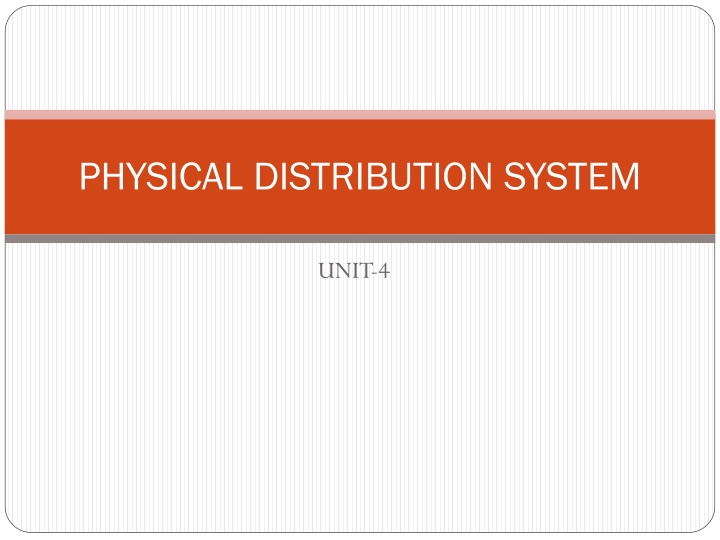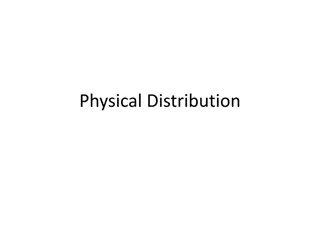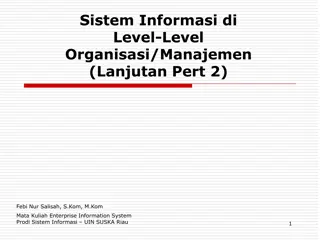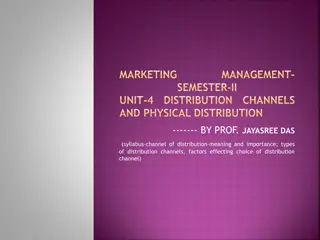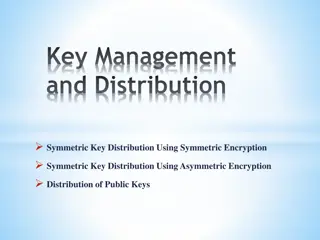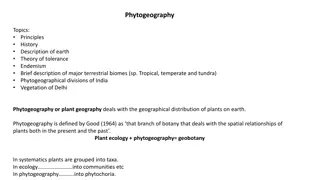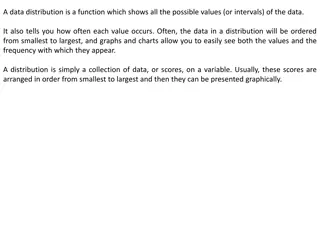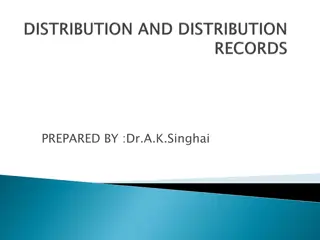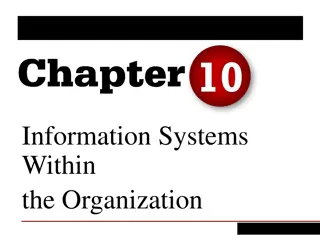The Essentials of Physical Distribution Systems
Physical distribution plays a vital role in efficiently moving goods from producers to consumers through activities like transportation, warehousing, inventory control, and more. This system focuses on consumer satisfaction, profit maximization, reducing distribution costs, and improving consumer services. It creates time and place utility, helps in cost reduction, stabilizes prices, and enhances consumer experiences.
Download Presentation

Please find below an Image/Link to download the presentation.
The content on the website is provided AS IS for your information and personal use only. It may not be sold, licensed, or shared on other websites without obtaining consent from the author.If you encounter any issues during the download, it is possible that the publisher has removed the file from their server.
You are allowed to download the files provided on this website for personal or commercial use, subject to the condition that they are used lawfully. All files are the property of their respective owners.
The content on the website is provided AS IS for your information and personal use only. It may not be sold, licensed, or shared on other websites without obtaining consent from the author.
E N D
Presentation Transcript
PHYSICAL DISTRIBUTION SYSTEM UNIT-4
INTRODUCTION TO PHYSICAL DISTRIBUTION SYSTEM Physical distribution is concerned with the physical movement of the goods from the producer to the consumer. It is an important part of marketing activity and a major component of marketing mix. It includes all those activities which help in efficient movement of goods from producer to consumer, such as transportation, warehousing, material handling, inventory control, order processing, market forecasting, packaging, plant and warehouse location and customer service. Philip Kotler has defined physical distribution as, Physical distribution involves planning, implementing and controlling the physical flow of materials and final goods from the point of origin of use to meet consumer needs at a profit.
Need &Objectives of Physical Need &Objectives of Physical Distribution: Distribution: Physical distribution has two broad objectives viz. consumer satisfaction and profit maximization. Apart from these two broad objectives, physical distribution has other objectives as follows: I. To make available the right goods in right quantity at right time and right place at least cost. ii. To achieve minimum inventory level and speedier transportation. iii.To establish price of products by effective management of physical distribution activities.
Importance of Physical Distribution Importance of Physical Distribution System: System: Its importance can be judged from following points: Creating Time and Place Utility: Physical distribution activities help in creating time and place utility. This is done through transportation and warehousing. Transportation system creates place utility as it makes available the goods at the right place where they are required. Warehousing creates time utility by storing the goods and releasing them when they are required. 1. 2. Helps in Reducing Distribution Cost: Physical distribution cost account for a major part of the price of the product. If these costs are handled systematically, decrease in costs of product can be there. Proper and systematic planning of transportation schedules and routes, warehousing location and operation, material handling, order processing, etc. can easily bring in cost economies.
Importance of Physical Distribution Importance of Physical Distribution System: System: 3. Helps in Stabilization of Price: Physical distribution helps in maintaining stable prices. Even customers expect price stability over a period of time. Proper use of transportation and warehousing facilities can help in matching demand with supply and thus ensure stabilization of price. 4. Improved Consumer Services: Consumer service in physical distribution means making products in right quantity available at right time and right place i.e. place where customer needs.
Components of Physical Distribution: Components of Physical Distribution: (1) Order Processing: Order processing is the starting point of any distribution activity. Order processing includes activities like receiving the order, handling the order, granting credit, invoicing, dispatching, collecting bills, etc. Each customer expects that the order placed by him is implemented without delay, and as per the specifications of the order. (2) Storage and Warehousing: Storage means making proper arrangements for retaining the goods in proper condition till they are demanded by customers. There are many products which are seasonally produced but are used throughout the year, they can be stored and later released.
Components of Physical Distribution: Components of Physical Distribution: (3) Inventory Control: Inventory control refers to efficient control of goods stored in warehouses. Maintaining adequate level of inventory is very essential for smooth flow of business. Inventory acts as a bridge between the orders of customers and production. They are the reservoir of the goods held in anticipation of sales. Therefore, it needs to be properly managed and controlled. Neither to small nor too large inventory should be maintained. (4) Material Handling: Material handling includes all those activities which are associated in moving products when it leaves the manufacturing plant but before it is loaded on the transport. This activity has been in existence since very long period of time, and now it has developed as a system.
Components of Physical Distribution: Components of Physical Distribution: (5)Transportation: Transportation as a component of physical distribution is concerned with the movement of goods from the warehouse to customer destination. It includes loading and unloading of goods and their movement from one place to another. In doing so it provides time and place utility. Transport accounts for a major portion of the distribution cost and of the total price of the product. Different modes of transportation are there like Road transport, railways, Airways, Water transport and pipeline from which a choice has to be made. i. Road Transport: This is an ancient form of transport and plays an important role in marketing. Road transport may be through different means like transport by animals (like bullock, camel), transport by human beings (like coolies or porters), transport by automobiles (like scooters, auto rickshaws, cars, truck buses etc.). Road transport is flexible and economical. However, it is unsuitable for long distances.
Components of Physical Distribution: Components of Physical Distribution: ii. Railways: It is suitable for transporting bulk goods over long distances. It is an economical mode because large volume of traffic is handled over large network of railways. However, it is inflexible as it is unfit to transport goods to rural areas. Further, it involves huge maintenance expenditure. iii. Water Transport: Water way is an important mode of transport for heavy and bulky goods in large quantities. It consists of inland water transport and ocean transport. Inland water transport is used for transporting goods within county and ocean transport is used to transport goods to other countries. Water transport is a cheapest form of transport, having great carrying capacity and is highly suitable for heavy and bulky goods, but it has low speed and higher degree of risk due to seasonal difficulties.
Components of Physical Distribution: Components of Physical Distribution: iv. Air Transport: Of late air transport has assumed significant importance as a mode of transport. Although it accounts for a small percentage of transportation, it is useful for perishable items, overnight packages, emergency supplies etc. The main disadvantage of air transport is that it has high freight charges, low carrying capacity and too much dependence on climatic conditions. v. Pipelines: These are specialized carriers design to transport the crude and refined petroleum and natural gas from wells to refineries and further to distribution centre. It is an economical mode as it involves less handling and labor cost, but it is the slowest mode of transportation and very limited in number.
What is a Distribution Channel? What is a Distribution Channel? A distribution channel (also called a marketing channel) is the path or route decided by the company to deliver its good or service to the customers. The route can be as short as a direct interaction between the company and the customer or can include several interconnected intermediaries like wholesalers, distributors, retailers, etc. Hence, a distribution channel can also be referred to as a set of interdependent intermediaries that help make a product available to the end customer.
Functions of Distribution Channels Functions of Distribution Channels In order to understand the importance of distribution channels, you need to understand that it doesn t just bridge the gap between the producer of a product and its user. Distribution channels provide time, place, and ownership utility. They make the product available when, where, and in which quantities the customer wants. But other than these transactional functions, marketing channels are also responsible to carry out the following functions: Logistics and Physical Distribution:Marketing channels are responsible for assembly, storage, sorting, and transportation of goods from manufacturers to customers. 1.
Functions of Distribution Channels Functions of Distribution Channels 2. Facilitation: Channels of distribution even provide pre-sale and post-purchase services like financing, maintenance, information dissemination and channel coordination 3.Creating Efficiencies:This is done in two ways:bulk breaking and creating assortments. Wholesalers and retailers purchase large quantities of goods from manufacturers but break the bulk by selling few at a time to many other channels or customers. They also offer different types of products at a single place which is a huge benefit to customers as they don t have to visit different retailers for different products.
Functions of Distribution Channels Functions of Distribution Channels 4.Sharing Risks: Since most of the channels buy the products beforehand, they also share the risk with the manufacturers and do everything possible to sell it. 5.Marketing: Distribution channels are also called marketing channels because they are among the core touch points where many marketing strategies are executed. They are in direct contact with the end customers and help the manufacturers in propagating the brand message and product benefits and other benefits to the customers.
Levels of Distribution Channels Levels of Distribution Channels Distribution Channels Indirect Channels Dual Direct Channel Distribution One-level Channel Two-Level Channel Three-Level Channel
Direct Channel or Zero Direct Channel or Zero- -level Channel (Manufacturer to Customer) (Manufacturer to Customer) Direct selling is one of the oldest forms of selling products. It doesn t involve the inclusion of an intermediary and the manufacturer gets in direct contact with the customer at the point of sale. Some examples of direct channels are peddling, brand retail stores, taking orders on the company s website, etc. Direct channels are usually used by manufacturers selling perishable goods, expensive goods, and whose target audience is geographically concentrated. For example, bakers, jewelers, etc. level Channel
Indirect Channels (Selling Through Indirect Channels (Selling Through Intermediaries) Intermediaries) When a manufacturer involves a middleman/intermediary to sell its product to the end customer, it is said to be using an indirect channel. Indirect channels can be classified into three types: One-level Channel (Manufacturer to Retailer to Customer):Retailers buy the product from the manufacturer and then sell it to the customers. One level channel of distribution works best for manufacturers dealing in shopping goods like clothes, shoes, furniture, toys, etc.
Indirect Channels (Selling Through Indirect Channels (Selling Through Intermediaries) Intermediaries) Two-Level Channel (Manufacturer to Wholesaler to Retailer to Customer):Wholesalers buy the bulk from the manufacturers, breaks it down into small packages and sells them to retailers who eventually sell it to the end customers. Goods which are durable, standardized and somewhat inexpensive and whose target audience isn t limited to a confined area use two- level channel of distribution.
Indirect Channels (Selling Through Indirect Channels (Selling Through Intermediaries) Intermediaries) Three-Level Channel (Manufacturer to Agent to Wholesaler to Retailer to Customer): Three level channel of distribution involves an agent besides the wholesaler and retailer who assists in selling goods. These agents come handy when goods need to move quickly into the market soon after the order is placed. They are given the duty to handle the product distribution of a specified area or district in return of a certain percentage commission. The agents can be categorized into super stockiest and carrying and forwarding agents. Both these agents keep the stock on behalf of the company. Super stockiest buy the stock from manufacturers and sell them to wholesalers and retailers of their area. Whereas, carrying and forwarding agents work on a commission basis and provide their warehouses and shipment expertise for order processing and last mile deliveries. Manufacturers opt for three-level marketing channel when the user base is spread all over the country and the demand of the product is very high.
Indirect Channels (Selling Through Indirect Channels (Selling Through Intermediaries) Intermediaries) Dual Distribution When a manufacturer uses more than one marketing channel simultaneously to reach the end user, he is said to be using the dual distribution strategy. They may open their own showrooms to sell the product directly while at the same time use internet marketplaces and other retailers to attract more customers.
Factors Determining the Choice of Factors Determining the Choice of Distribution Cha Distribution Channels nnels
Factors Determining the Choice of Factors Determining the Choice of Distribution Cha Distribution Channels nnels Market Characteristics This includes the number of customers, their geographical location, buying habits, tastes and capacity and frequency of purchase, etc. Direct channels suit businesses whose target audience lives in a geographically confined area, who require direct contact with the manufacturer and are not that frequent in repeating purchases In cases of customers being geographically dispersed or residing in a different country, manufacturers are suggested to use indirect channels.
Factors Determining the Choice of Factors Determining the Choice of Distribution Cha Distribution Channels nnels Product Characteristics Product cost, technicality, perishability and whether they are standardised or custom-made play a major role in selecting the channel of distribution for them. Perishable goods like fruits, vegetables and dairy products can t afford to use longer channels as they may perish during their transit. Manufacturers of these goods often opt for direct or single level channels of distribution. Whereas, non- perishable goods like soaps, toothpaste, etc. require longer channels as they need to reach customers who reside in areas which are geographically diverse.
Factors Determining the Choice of Factors Determining the Choice of Distribution Cha Distribution Channels nnels Competition Characteristics The choice of the marketing channel is also affected by the channel selected by the competitors in the market. Usually, the firms tend to use a similar channel as used by the competitors. But some firms, to stand out and appeal to the consumer, use a different distribution channel than the competitors. For example, when all the smartphones were selling in the retail market, some companies partnered with Amazon and used the scarcity principle to launch their smartphone as Amazon exclusive.
Factors Determining the Choice of Factors Determining the Choice of Distribution Cha Distribution Channels nnels Company Characteristics Financial strength, management expertise, and the desire for control act as important factors while deciding the route the product will take before being available to the end user. A company having a large amount of funds and good management expertise (people who have sufficient knowledge and expertise of distribution) can create the distribution channels of its own but a company with low financial stability and management expertise has to rely on third-party distributors.
Recent Development in Sales & Distribution Scenario There are four key areas that are changing and have all seemed to happen within the same timeframe. With these swift changes, the Sales & distribution aspect of production has become a different atmosphere, with changes being in the following areas: Options - Customers like to have a choice - making sure that you are the best choice becomes essential. Becoming the best distribution choice can be done by integration with distributors who offer various other products. By doing this, you are beating out the competition by having a wide variety all in one package. Convenience - Having a location that is closer to customers will enable them to want your product more, simply out of convenience. As customers are ambitious with buying, this creates a demand for receiving a product quickly. A nearby location to customers is extremely beneficial to distributors. 1. 2.
Recent Development in Sales & Distribution Scenario 3. Experience -This term can range from availability of product to product description enhancements. This area also includes order history, shipping and refunds, management of productivity, and various other aspects. Customer experience is extremely important to distribution - after all, happy customers mean more sales. 4. Cost -Arguably one of the most important factors pertaining to customers, having a cost friendly distribution network can lead to more sales. When you integrate options and diversify your product line, distribution can cost less through large orders and reduced delivery times. All in all, this creates a lower, more price-friendly option for your consumers.
